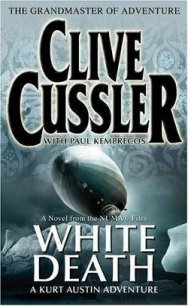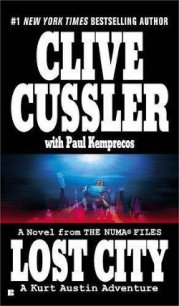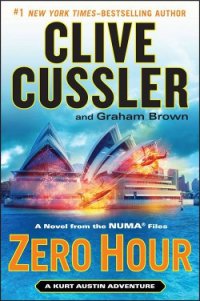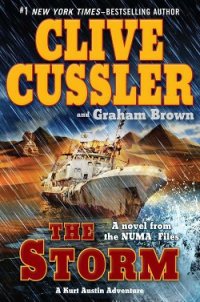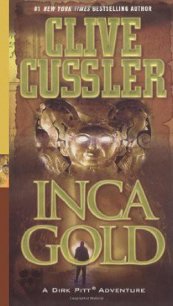The Navigator - Cussler Clive (читаем книги онлайн бесплатно полностью .TXT) 📗
Zavala scanned the wide expanse of sun-sparkled water. “What’s the wreck tally on the bottom of the Chesapeake?” he asked, raising his voice to be heard over the buzz of the motor.
Austin looked up from the chart. “About eighteen hundred at last count. They range from a sixteenth-century wreck of TangierIsland to the Cuyahoga, a Coast Guard cutter that went down after a collision. But the historian at NUMA was clueless about the target the satellite picked up.”
“What kind of depth are we talking about?”
“The Chesapeake’s pretty shallow, for the most part,” Austin replied. “Averages about twenty-one feet, although it’s laced with troughs that reach nearly two hundred feet.” He tapped the chart with his finger. “From the looks of it, our target sank into one of these deep holes.”
The powerboat continued south, skimming over the tops of two-foot seas past oyster boats and sailing craft. There was a steady stream of traffic in both directions along the Intercoastal Waterway, which ran down the middle of the Chesapeake.
Less than an hour after leaving the boatyard, Austin again glanced at the GPS and signaled to Zavala, who backed off the throttle and steered the boat to follow Austin’s pointing finger. When they were on-site Austin pointed down toward the water and yelled:
“Here.”
The boat plowed to a stop and Zavala killed the motor. Austin set the GPS aside and threw the anchor over the side. The boat rocked in the waves a few hundred yards from a small island. The boat’s depth finder indicated that the water under their hull was forty-six feet. He and Zavala pored over the satellite photo Wilmut had provided. The faint outline of a ship was clear. It should be right under their hull.
Austin opened a plastic case and lifted out a SeaBotix Remote-Operated Vehicle that was about the size and shape of a canister vacuum cleaner. NUMA had ROVs that were as big as a car, and Austin could have drawn upon an array of the sophisticated remote sensing devices, but he wanted to move fast. He had decided against a time-consuming magnetometer or side-scan sonar survey in favor of a shallow-water vehicle that was portable and easily transported.
At one end of the bright red plastic housing was a high-resolution color camera and halogen lights. At the other end was a pair of powerful thrusters. The ROV had a lateral thruster that could shift it sideways and a vertical thruster for up and down. Metal frameworks on each side of the vehicle served a dual purpose as runners and housing protection.
Zavala snapped open the lid on the other case, which contained the ROV’s eight-inch television monitor and controls. He was a skilled pilot, and the single-stick control would be easy to use. He and Austin connected the three-hundred-foot-long low-drag umbilical to the vehicle and control box. Austin lifted the ROV by the handle in the top of the housing and dropped it into the water. Zavala put the vehicle through a few tricky maneuvers to get a feel for the controls. Then he pointed the ROV toward the bottom in a shallow dive and powered the thrusters.
The ROV quickly descended to forty feet. Zavala leveled the vehicle off and checked the TV monitor. Twin cones of light illuminated the muddy bottom. There was no sign of a wreck. He had the vehicle execute a series of parallel lines, as if he were mowing a lawn. Still no wreck.
“I hope our target wasn’t a NUMASat hiccup,” he said. He turned to Austin, who had been peering over his shoulder.
“Not a chance,” Austin said. “Set up a new search pattern to starboard. Keep it tight.”
Zavala activated the lateral thrusters and shifted the mini-ROV to the right. He started a new pattern with twenty-five-foot-long parallel turns. Halfway through the new search, the ROV’s lights picked out a dark, curving line that protruded from the bottom.
Zavala brought the vehicle to a hover. “That’s either a sea serpent rib or a ship’s timber.”
The image on the monitor brought a grin to Austin’s face.
“I’d say we’ve got ourselves a wreck,” he said. “Remind me to sacrifice a Hobbit to the Eye of Sauron.”
Zavala powered the ROV so that it moved past the object. More ship’s ribs came into view. The skeletal outlines of the wreck could be discerned. The timbers gradually diminished in size as the ROV passed nearer the bow section.
“The wood is pretty well preserved, except for the upper ends, where it seems to be charred,” Zavala said.
“That would account for the sinking. She burned to the waterline.”
“How long do you figure her to be?”
Austin squinted at the screen. “A hundred fifty feet. Maybe more. What’s that, off to the right?”
Zavala put the ROV into a quick turn. The lights picked up what looked like a long wooden animal snout. The upper part of the head was burned beyond recognition.
“Looks like part of a big hobbyhorse,” Zavala said.
Austin’s pulse quickened. He reached into his duffel bag and pulled out a waterproof folder of transparent plastic. Inside was the computer-generated ship rendering that the Trouts had given him. He held the picture close to the screen. The horse snout on the monitor and in the picture were almost identical.
“Guess again, amigo. We may be the first people in more than two thousand years to set eyes on a Phoenician ship of Tarshish.”
Zavala’s face lit up. “I’d trade a case of anejo tequila for a glimpse of this lady when it was still afloat.”
He moved the vehicle slowly along the port side of the wreck.
Austin saw a dark round shape lying about dead center in the hull. He tapped the screen. “What’s this?”
Zavala cautiously powered the vehicle inches forward.
The ROV’s lights picked out a metal grating partially covered by marine growth. He turned the vehicle around and used the force of its thrusters to clear away the sand around the object.
Austin said, “It’s a diver’s helmet.”
“I know the Phoenicians were clever, but I didn’t know they were into hard-hat diving.”
“They weren’t. Someone beat us to the wreck, and from the looks of it he’s still down there.”
Zavala put the ROV in a hover that would keep the helmet in view. Austin laid his scuba gear out on the deck. He stripped down to a bathing suit and got into a neoprene wet suit, boots, gloves, and hood. He pulled on his fins. Zavala helped him with his weight belt and air tank. Austin did a quick gear check and tested the regulator. Then he brought a mask down over his eyes and clamped the mouthpiece between his teeth. He sat on the gunwale and rolled backward into the water.
Austin sank several feet in a cloud of bubbles. He felt a quick chill before the cold water seeping between skin and suit warmed to body temperature. With powerful kicks of his muscular legs, he powered himself down through the darkening water toward the silvery green glow from the ROV lights.
Austin came down practically on top of the vehicle, then swam around in front of the ROV’s camera lens and gave a thumbs-up. Zavala tilted the front of the ROV up and down as if it were nodding. Austin waved back and swam over to examine the ribs. The wood was definitely charred.
He was turning back to the helmet when he saw a rectangular object lying nearby. He picked up what appeared to be a stone or clay tablet, about eight inches square and a couple of inches thick. Lines were cut into the surface on one side.
Austin slipped the tablet into a stuff bag attached to his buoyancy compensator and gave the helmet his full attention. He cleared the vegetation from around the base. The helmet was still attached to a breastplate. He dug into the muck. Shreds of rotting canvas could be seen fringing the outer rim of the breastplate.
Austin felt a chill that was not entirely due to the water temperature.
He unhooked a waterproof flashlight from his BC, snapped it on, and pointed the beam through the grate. Staring back at him were the empty eyes of a human skull.
